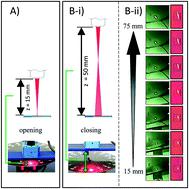Our official English website, www.x-mol.net, welcomes your feedback! (Note: you will need to create a separate account there.)
Optically-controlled closable microvalves for polymeric centrifugal microfluidic devices.
Lab on a Chip ( IF 6.1 ) Pub Date : 2020-03-06 , DOI: 10.1039/c9lc01187k M Shane Woolf 1 , Leah M Dignan , Hannah M Lewis , Christopher J Tomley , Aeren Q Nauman , James P Landers
Lab on a Chip ( IF 6.1 ) Pub Date : 2020-03-06 , DOI: 10.1039/c9lc01187k M Shane Woolf 1 , Leah M Dignan , Hannah M Lewis , Christopher J Tomley , Aeren Q Nauman , James P Landers
Affiliation

|
Microvalving is a pivotal component in many microfluidic lab-on-a-chip platforms and micro-total analysis systems (μTAS). Effective valving is essential for the integration of multiple unit operations, such as, liquid transport, mixing, aliquoting, metering, washing, and fractionation. The ideal microfluidic system integrates numerous, sequential unit operations, provides precise spaciotemporal reagent release and flow control, and is amenable to rapid, low-cost fabrication and prototyping. Centrifugal microfluidics is an attractive approach that minimizes the need for supporting peripheral hardware. However, many of the microfluidic valving methods described in the literature suffer from operational limitations and fail when high rotational frequencies or pressure heads are required early in the analytical process. Current approaches to valve closure add unnecessary complexity to the microfluidic architecture, require the incorporation of additional materials such as wax, and entail extra fabrication steps or processes. Herein we report the characterization and optimization of a laser-actuated, closable valve method for polymeric microfluidic devices that ameliorates these shortcomings. Under typical operational conditions (rcf ≤605 × g) a success rate >99% was observed, i.e. successful valve closures remained leak free through 605 × g. Implementation of the laser-actuated closable valving system is demonstrated on an automated, centrifugally driven dynamic solid phase extraction (dSPE) device. Compatibility of this laser-actuated valve closure approach with commercially available polymerase chain reaction (PCR) assays is established by the generation of full 18-plex STR profiles from DNA purified via on-disc dSPE. This novel approach promises to simplify microscale valving, improve functionality by increasing the number of integrated unit operations, and allow for the automation of progressively complex biochemical assays.
中文翻译:

用于聚合物离心微流控设备的光控可关闭微阀。
微阀是许多微流控芯片实验室平台和微总分析系统(μTAS)的关键组件。有效的阀门对于整合多个单元操作至关重要,例如液体传输,混合,分装,计量,洗涤和分馏。理想的微流控系统集成了许多连续的单元操作,可提供精确的时空试剂释放和流量控制,并适合快速,低成本的制造和原型制作。离心微流体技术是一种有吸引力的方法,可最大限度地减少对支持外围硬件的需求。但是,文献中描述的许多微流体阀门方法都存在操作局限性,并且在分析过程的早期需要高旋转频率或压头时失败。当前的阀关闭方法使微流体结构增加了不必要的复杂性,需要结合额外的材料,例如蜡,并且需要额外的制造步骤或工艺。在本文中,我们报告了可改善这些缺点的用于聚合物微流体装置的激光驱动,可关闭阀方法的特性和优化。在典型工作条件下(rcf≤605×g)观察到成功率> 99%,即成功的阀门关闭保持605× g无泄漏。在自动,离心驱动的动态固相萃取(dSPE)设备上演示了激光驱动的可关闭阀门系统的实现。通过从通过盘上dSPE纯化的DNA生成完整的18重STR图谱,可以确定这种激光驱动的阀门关闭方法与市售聚合酶链反应(PCR)分析的兼容性。这种新颖的方法有望简化微型阀门,通过增加集成单元操作的数量来提高功能性,并允许逐步复杂的生化分析的自动化。
更新日期:2020-04-24
中文翻译:

用于聚合物离心微流控设备的光控可关闭微阀。
微阀是许多微流控芯片实验室平台和微总分析系统(μTAS)的关键组件。有效的阀门对于整合多个单元操作至关重要,例如液体传输,混合,分装,计量,洗涤和分馏。理想的微流控系统集成了许多连续的单元操作,可提供精确的时空试剂释放和流量控制,并适合快速,低成本的制造和原型制作。离心微流体技术是一种有吸引力的方法,可最大限度地减少对支持外围硬件的需求。但是,文献中描述的许多微流体阀门方法都存在操作局限性,并且在分析过程的早期需要高旋转频率或压头时失败。当前的阀关闭方法使微流体结构增加了不必要的复杂性,需要结合额外的材料,例如蜡,并且需要额外的制造步骤或工艺。在本文中,我们报告了可改善这些缺点的用于聚合物微流体装置的激光驱动,可关闭阀方法的特性和优化。在典型工作条件下(rcf≤605×g)观察到成功率> 99%,即成功的阀门关闭保持605× g无泄漏。在自动,离心驱动的动态固相萃取(dSPE)设备上演示了激光驱动的可关闭阀门系统的实现。通过从通过盘上dSPE纯化的DNA生成完整的18重STR图谱,可以确定这种激光驱动的阀门关闭方法与市售聚合酶链反应(PCR)分析的兼容性。这种新颖的方法有望简化微型阀门,通过增加集成单元操作的数量来提高功能性,并允许逐步复杂的生化分析的自动化。

























 京公网安备 11010802027423号
京公网安备 11010802027423号